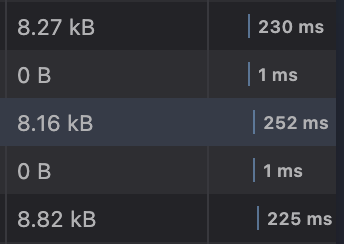The Mess I Inherited
When I first joined the company, I naturally took a quick dive into the codebase to get a general understanding of how it works. This helped me quickly grasp the structure of the codebase, when I reached the core functionality in the backend services I was welcomed with a 200 line sql query that no matter how much I tried to read it or understand it, it was a big mess with many joins and sub queries, and I wasn't even sure what it was doing.
Simply, it felt like navigating a jungle in the dark, yet after finding the way to fix all this (not to brag but I literally 10x'ed it lol) it has become a big personal achievement for me, and a big step towards becoming a better engineer.

The Philosophy of Separation of Concerns
The general definition of separation of concerns is that each component of a system should be responsible for only one thing, but to me this sounds like a very vague definition or strategy that may make a codebase have 1000 components functions or classes that are absolutely just bloating the codebase, and I'm not sure if this is the right way to go about it.
A better way to think about it is that each component should be responsible for one middle sized piece of functionality or logic, of course you should not do too much or too little with each component, but the idea is that each component should be responsible for one thing, and that thing should be as small as possible, yet as big as possible in the same time if that makes sense.
Many people think the database is only meant to store data, but it's actually meant to store & manage, I thought that separating logic in the backend service was better than in the database because database logic might create bottlenecks and slow down performance, but after research I found out that it will boost the performance of the service, many calculations and functionalities will be done faster if the the database handled them instead of your code doing it since the major databases already have built in functions for your case or already are optimized for it behind the scenes.
The Art of Database Design
Good database design isn't just about getting the relations right, or the data types right, its about understanding how the data is going to be used, retrieved and queried, when making the structure there has to be a general idea of how each group of data will be queried. In many cases the database model will be solid but without thought of how it will be queried it can make the process very complex and slow or even having to rewrite the entire database model.
In my case restructuring the database model wasn't a viable option since we don't have the time to do it due to the fact that we have many business and product plans we need to follow, so I gave in and decided to tackle the 200 line sql query that was causing me so much pain to start with. One reason why this query was so large is the lack of separation of concerns, so just by creating more controllers while also bringing the complexity of the query down, I was able to make the smaller queries much more readable, performant and easier to maintain.
Also there were many queries that could be grouped together, for example there was a query that was getting the user object but to get the user photo url to retrieve it from the bucket it had a separate query that would run in a loop for each user object you fetched, so imagine that you fetched 100 users, you would have to run 100 queries to get the user photos, so I just grouped them together and made a single query that would get all the user photos in one query.
Before Optimization: Fetching Users and Their Photos Separately
import { db } from "@/db";
import { users, userPhotos } from "@/db/schema";
import { eq } from "drizzle-orm";
import { sql, eq } from "drizzle-orm";
async function getUsersWithPhotos() {
const fetchedUsers = await db.execute(sql`
SELECT
users.id,
users.name,
users.email,
userProfiles.bio
FROM users
LEFT JOIN userProfiles ON users.id = userProfiles.userId
`);
for (const user of fetchedUsers) {
const photo = await db
.select({ url: userPhotos.url })
.from(userPhotos)
.where(eq(userPhotos.userId, user.id))
.orderBy(userPhotos.createdAt)
.limit(1);
user.photo = photo.length > 0 ? photo[0].url : null;
}
return fetchedUsers;
}After Optimization: Fetching Users and Their Photos Combined
import { sql } from "drizzle-orm";
async function getUsersWithPhotos() {
const fetchedUsers = await db.execute(sql`
SELECT
users.id,
users.name,
users.email,
userProfiles.bio,
latestPhotos.url AS photo
FROM users
LEFT JOIN userProfiles ON users.id = userProfiles.userId
LEFT JOIN (
SELECT userPhotos.userId, userPhotos.url
FROM userPhotos
WHERE userPhotos.createdAt = (
SELECT MAX(createdAt)
FROM userPhotos p
WHERE p.userId = userPhotos.userId
)
) AS latestPhotos ON users.id = latestPhotos.userId
`);
return fetchedUsers;
}Additionally, another big thing you should always have in mind is Fetch what you need, even if the query is small if every time I wanted to get the user object I would have to fetch the entire user object with all data relating to it, this is a waste of resources and can cause a lot of overhead, if you want make your app fast you should rely on database level filtering instead of fetching the entire object and filtering it in your code.
Inefficient: Fetching All User Data
import { sql } from "drizzle-orm";
async function getUsersWithPhotos() {
// Fetch ALL user data (including unnecessary fields)
const users = await db.execute(sql`SELECT * FROM users`);
const filteredUsers = [];
for (const user of users) {
const photo = await db.execute(sql`
SELECT url FROM userPhotos WHERE userId = ${user.id} ORDER BY createdAt DESC LIMIT 1
`);
// We manually extract only the necessary fields
filteredUsers.push({
id: user.id,
name: user.name,
photo: photo.length > 0 ? photo[0].url : null,
});
// We fetched ALL columns but only needed three
// making the query unnecessarily slow.
}
return filteredUsers;
}After Optimization: Fetching Only Necessary Data
import { sql } from "drizzle-orm";
async function getUsersWithPhotos() {
const users = await db.execute(sql`
SELECT
users.id,
users.name,
latestPhotos.url AS photo
FROM users
LEFT JOIN (
SELECT userPhotos.userId, userPhotos.url
FROM userPhotos
WHERE userPhotos.createdAt = (
SELECT MAX(createdAt)
FROM userPhotos p WHERE p.userId = userPhotos.userId
)
) AS latestPhotos ON users.id = latestPhotos.userId
`);
// No extra filtering needed, already optimized!
return users;
}The 10x Optimization
After optimizing the query, the code was much more readable, performant and easier to maintain, although the optimizations I mentioned above may seem small and insignificant such as making the queries smaller or more optimal and also just fetching the actual thing we need making the request smaller, but they make a big difference especially in large codebases, or service that has to be fast and performant.
This all happened because I was responsible of a feature that required Infinite Scrolling, to put it into perspective after implementing the feature and before the optimizations each page (section you scroll down to) would take about 3 seconds to load, imagine scrolling on instagram or tik tok and you reach the end of the page, how frustrating would it be to wait for 3 seconds every few posts for the nest to load.
Very proud that all the digging and optimizations I did was worth it, I have managed to bring it down to an average of sub 0.3 seconds !
Now it feels instantaneous, you wont even notice reaching the end of the page.
After Optimization: Average response time

Bonus: Pro Tips learned from this Experience
Before we wrap this up, let’s talk about some bonus tips that can take your database optimization to the next level. These are the little things that, when done right, can make a huge difference in how your queries perform. Think of them as the secret sauce to keeping your database running smoothly.
Indexing is Your Best Friend
Indexes are like the table of contents in a book,they help the database find what it’s looking for without scanning every single page. If you’re querying a column frequently (like userId or accountName), slap an index on it. But be careful, over indexing can slow down writes, so only index what you actually need. It’s a balancing act, but when done right, it’s pure magic.
Use EXPLAIN to Understand What’s Happening Under the Hood
If you’re not using EXPLAIN (or its equivalent in your database), trust me when I say you’re wasting your time. database is executing your query what indexes it’s using, how it’s joining tables, and where the bottlenecks are. It’s like having X ray vision for your queries.
When I ran EXPLAIN on that monstrous 200 line query, it was amazing. I could see exactly where the database was struggling whether it was a missing index, a poorly optimized join, or a subquery that was running way too many times. With this knowledge, I was able to refactor the query step by step, making it faster and more efficient.
Test, Test, and Test Some More
Optimization isn’t a one and done deal. You need to test your changes thoroughly to make sure they’re actually improving performance. This means running your queries in different scenarios small datasets, large datasets, edge cases, you name it. And don’t just rely on local testing run your optimized queries in a staging environment that mimics production as closely as possible.
In my case, after optimizing the infinite scroll feature, I ran a bunch of tests to simulate real world usage. I loaded hundreds of items, scrolled through pages, and monitored the response times. It was only after seeing consistent sub 0.3 second loads that I felt confident pushing the changes to next release.

Lessons Learned: The Journey to Becoming a Better Engineer
This whole experience was a huge learning curve for me, and it taught me some valuable lessons that I’ll carry with me throughout my career. Here’s the TL;DR of what I took away:
-
Separation of Concerns is a Guiding Light, Not a Rulebook, It’s not about splitting everything into a million tiny pieces. It’s about finding the right balance keeping your components focused but not overly fragmented. Think of it like organizing your closet: you don’t want one giant pile of clothes, but you also don’t want a separate drawer for every sock.
-
Databases Are Smarter Than You Think, Don’t be afraid to let the database do the heavy lifting. It’s optimized for this stuff, and chances are, it’ll do a better job than your code. Trust the database, but also understand how it works so you can use it effectively.
-
Optimization is a Mindset, It’s not just about making things faster it’s about thinking critically about how your code interacts with the database, how data flows through your system, and where the bottlenecks are. Every small improvement adds up, and over time, those improvements can lead to a 10x boost in performance.
-
Patience and Persistence Pay Off, When I first saw that 200 line query, I wanted to cry. But breaking it down, understanding it piece by piece, and iterating on it taught me so much. It’s a reminder that even the messiest problems can be solved with patience and persistence.
-
Celebrate the Wins, Bringing that query down from 3 seconds to 0.3 seconds felt like winning a marathon. It’s important to celebrate these moments they’re a reminder of how far you’ve come and how much you’ve grown as an engineer.
So, if you’re staring down a massive, convoluted query or a database model that feels like a maze, don’t panic. Take a deep breath, grab a cup of coffee, and start chipping away at it. Remember, every optimization no -matter how small- is a step toward a faster, more efficient system. And who knows? You might just 10x your performance Just like the way I did ^-^.